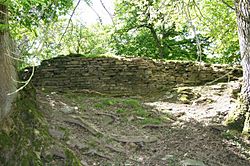Aberedw Castle facts for kids
Quick facts for kids Aberedw Castle |
|
|---|---|
| Powys, Wales | |

The best preserved part of Aberedw Castle
|
|
| Type | Castle |
| Site information | |
| Condition | Ruined |
| Site history | |
| Built | 1093 |
| Demolished | Partially demolished in the 19th century |
The Aberedw Castle is an old castle found in the small village of Aberedw. This village is located in Powys, which is in Mid-Wales. The castle was built a long time ago, in the late 1100s. It probably took the place of an even older castle nearby. That older castle was a "motte and bailey" type, which means it had a big mound of earth (the motte) with a wooden tower, and a fenced-in area (the bailey).
Contents
History of Aberedw Castle
Building the Castle
King Edward I of England gave permission to Walter Heckelutel to build or strengthen this castle. This happened on November 24, 1284. This special permission was called a "Licence to Crenellate." It meant he could add battlements and defenses to the castle. Some people think this was a way for the King to control powerful lords.
However, some historians believe the castle might be even older. They suggest it could date back to 1093. This was when the Normans invaded South Wales. The Normans were people from Normandy in France. They conquered England in 1066 and then moved into Wales.
Llywelyn, the Last Prince
Aberedw Castle is most famous because of its connection to Llywelyn ap Gruffudd. He was known as the very last native Prince of Wales. This means he was the last Welsh ruler to hold that title before Wales was fully taken over by England.
Llywelyn made his last stand at Aberedw. He was hiding here before he was killed in 1282. A man named Adam Francton killed him. Llywelyn's head was then sent to the King of England. This event marked a very sad moment in Welsh history.
What the Castle Looked Like
Castle Design and Features
Aberedw Castle was built from stone and had a rectangular shape. It had round towers at each corner. These towers were about 6 meters (20 feet) across. A wide moat surrounded the castle. This moat was like a ditch filled with water, about 10 to 15 meters (33 to 49 feet) wide.
The castle was built to the east of the River Wye. You can still see parts of the moat on three sides of the castle today. To get into the castle, people would cross a causeway. This was a raised path over the ditch on the east side. There are also some signs that there were buildings inside the castle walls. The eastern towers even show signs of old latrine chutes, which were like early toilets.
The Castle Today
Today, Aberedw Castle is mostly a ruin. A large part of its west side was destroyed in the 1800s. This happened when a railway line was being built. Many stones from the castle were used to build the railway tracks. The ruins are not in great shape now. The weather and time are causing the site to wear away, which is called erosion.

